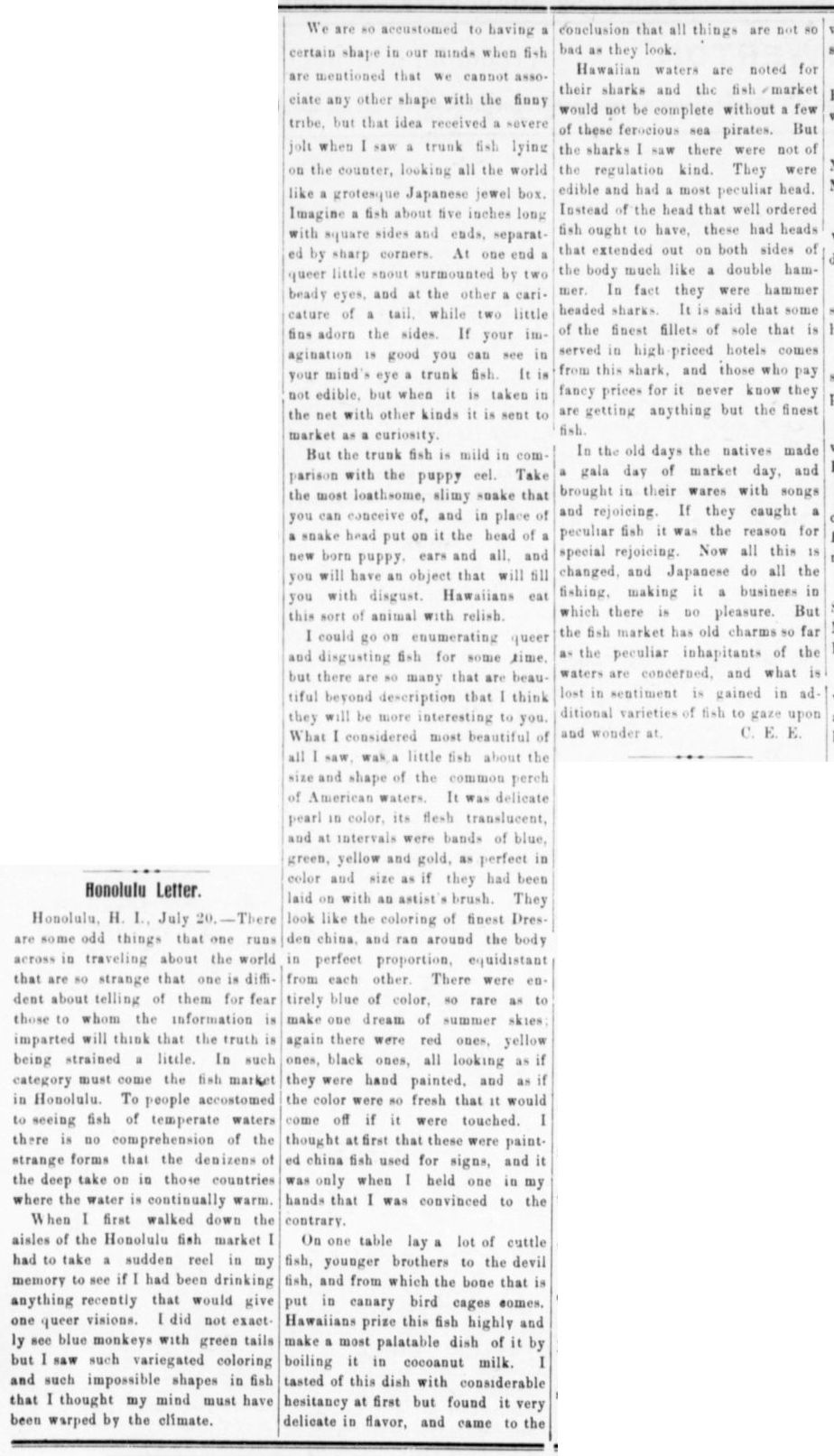July 20, 1907
Honolulu Letter.
Honolulu, H. I., July 20.--
There are some odd things that one runs across in traveling about the world that are so strange that one is diffident about telling of them for fear those to whom the information is imparted will think that the truth is being strained a little. In such category must come the fish market in Honolulu. To people accostomed [accustomed] to seeing fish of temperate waters there is no comprehension of the strange forms that the denizens of the deep take on in those countries where the water is continually warm.
When I first walked down the aisles of the Honolulu fish market I had to take a sudden reel in my memory to see if I had been drinking anything recently that would give one queer visions. I did not exactly see blue monkeys with green tails but I saw such variegated coloring and such impossible shapes in fish that I thought my mind must have been warped by the climate.
We are so accustomed to having a certain shape in our minds when fish are mentioned that we cannot associate any other shape with the finny tribe, but that idea received a severe jolt when I saw a trunk fish lying on the counter, looking all the world like a grotesque Japanese jewel box. Imagine a fish about five inches long with square sides and ends, separated by sharp corners. At one end a queer little snout surmounted by two beady eyes, and at the other a carricature of a tail, while two little fins adorn the sides. If your imagination is good you can see in your mind's eye a trunk fish. It is not edible, but when it is taken in the net with other kinds it is sent to market as a curiosity.
But the trunk fish is mild in comparison with the puppy eel. Take the most loathsome, slimy snake that you can conceive of, and in place of a snake head put on it the head of a new born puppy, ears and all, and you will have an object that will fill you with disgust. Hawaiians eat this sort of animal with relish.
I could go on enumerating queer and disgusting fish for some time, but there are so many that are beautiful beyond description that I think they will be more interesting to you. What I considered most beautiful of all I saw, was a little fish about the size and shape of the common perch of American waters. It was delicate pearl in color, its flesh translucent, and at intervals were bands of blue, green, yellow and gold, as perfect in color and size as if they had been laid on with an artist's brush. They look like the coloring of finest Dresden china, and ran around the body in perfect proportion, equidistant from each other. There were entirely blue of color, so rare as to make one dream of summer skies; again there were red ones, yellow ones, black ones, all looking as if they were hand painted, and as if the color were so fresh that it would come off if it were touched. I thought at first that these were painted china fish used for signs, and it was only when I held one in my hands that I was convinced to the contrary.
On one table lay a lot of cuttle fish, younger brothers to the devil fish, and from which the bone that is put in canary bird cages comes. Hawaiians prize this fish highly and make a most palatable dish of it by boiling it in cocoanut milk. I tasted of this dish with considerable hesitancy at first but found it very delicate in flavor, and came to the conclusion that all things are not so bad as they look.
Hawaiian waters are noted for their sharks and the fish market would not be complete without a few of these ferocious sea pirates. But the sharks I saw there were not of the regulation kind. They were edible and had a most peculiar head. Instead of the head that well ordered fish ought to have, these had heads that extended out on both sides of the body much like a double hammer. In fact they were hammer headed sharks. It is said that some of the finest fillets of sole that is served in high-priced hotels comes from this shark, and those who pay fancy prices for it never know they are getting anything but the finest fish.
In the old days the natives made a gala day of market day, and brought in their wares with songs and rejoicing. If they caught a peculiar fish it was the reason for special rejoicing. Now all this is changed, and Japanese do all the fishing, making it a business in which there is no pleasure. But the fish market has old charms so far as the peculiar inhabitants of the waters are concerned, and what is lost in sentiment is gained in additional varieties of fish to gaze upon and wonder at.
C. E. E.
Source: Crittenden Record-Press. (Marion, Ky.) 1907-1918, October 31, 1907, Image 7 - Chronicling America - The Library of Congress.
[My comments are in brackets.]
